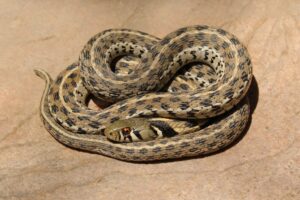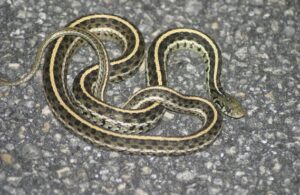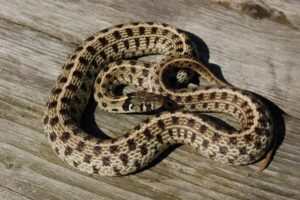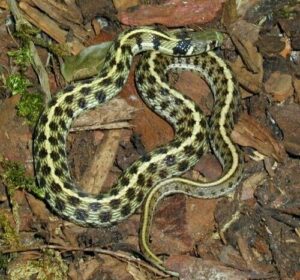The checkered garter snake belongs to the sub-family Natricinae within the Colubridae family. The ‘marcianus’ in its specific name is in honor of American Brigadier General Randolph B. Marcy, who led mid-19th century surveying expeditions to the frontier areas. The medium-sized garter snake is a good swimmer and dives into the water when startled. It also loves to climb.
Scientific Classifications
- Suborder:Serpentes
- Family:Colubridae
- Genus:Thamnophis
- Species:T. marcianus
Conservation Status
Subspecies
This snake has three recognized subspecies.
- Thamnophis marcianus marcianus
- Thamnophis marcianus praeocularis
- Thamnophis marcianus bovalli
Description
Size
The total size of the full-grown snakes, including their tails, is usually 18-24 in (46-61 cm), but they can grow to 42 in (107 cm).
Color and Appearance
The typically greenish-colored snake has a prominent black checkerboard pattern running down its back. This is from where it gets its common name. The belly is yellowish, and there is a big cream-colored crescent-shaped mark on each side of the head.
Are They Dangerous to Humans
Provocation makes it strike, bite and release a foul-smelling liquid from its cloaca to deter its attacker. It is in possession of a mild neurotoxic venom but cannot kill humans due to the small amounts in which it is produced. Plus, these garter snakes lack an effective mechanism for delivering the venom produced by the Duvernoy’s gland behind their eyes. They have enlarged teeth at the back of their mouths, but their gums are much bigger. The venom is delivered into the wounds by a chewing action.
Checkered Garter Snakes at a Glance
Distribution
This garter snake is a native of Mexico, the southwestern United States, and Central America.
Habitat
It prefers to live in deserts and grasslands, in close proximity to water.
Lifespan
The checkered garter snake lives for up to 15 years.
Predators
Their predators are grey hawks, American crows, raccoons, striped skunks, red foxes, domestic cats, and milk snakes. Humans also kill the snakes to their uniquely patterned skin to use them in making clothing and accessories.
Diet
Its diet includes toads, small frogs, earthworms, and small fish that are killed by envenomation.

Reproduction
Ovoviviparous (gives birth to live young from eggs that hatch inside the body)
The polygynous snakes mate from late March to early April. At that time, the females stop eating, and groups of males emit strong pheromones for the females to find them. A female gives birth to a brood of 6-35 young between July to September.
Care Sheet
It is one of the easiest garter snakes to keep as a pet. Even a wild-caught individual can be tamed in a matter of a few days with proper handling. The hardy captive is frequently available in the exotic pet trade.

Size of the Enclosure: The vivarium length needs to be at least ⅔rd the snake’s length. So, for a 3ft snake, you can get a 2ft tank. Usually, 2ft-3ft vivariums are suitable for the active snakes. The hatchlings can be kept in a faunarium or a small hatchling tub.
Temperature: The cool end of the tank should be kept at 71°F with the hot end at 86°F during the day. At night time, the temperature gradient can drop to 60-68°F.
Humidity: 30-60% humidity is ideal for the pet setup. A bowl of water big enough for the pet to submerge itself should be provided in the cage.
Substrate: A deep substrate of a mixture of half play sand and half peat moss or coconut fiber, aspen shavings, sphagnum moss, Sani-chips, or sterile potting soil are ideal for the snake that loves to burrow. The substrate should be kept dry.
Feeding: The pets can be fed live or freeze-thawed mice. But being a fussy eater, it can refuse mice at any point of time. Then it can be given fish fillets. The feeding frequency should be once or twice a week, depending on the size of the snake and the food offered.
Source
naturalworldpets.co.uk, i0.wp.com, snake-facts.weebly.com, morphmarket.com, phenology.mwparc.org









